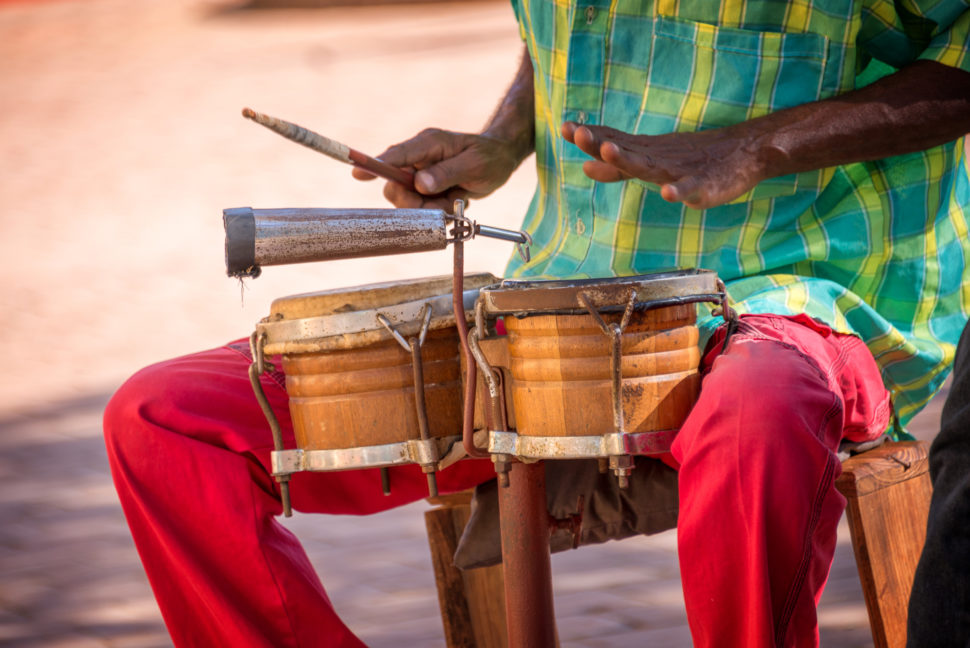From dancehall to calypso, a music lover’s guide to the Caribbean
Written by Falene Nurse
The Caribbean conjures up images of crystal clear waters, sunshine, and delicious cuisine. But Caribbean music tends to vary in rhythm and beat from island to island. Made up of over 28 nations, a rich tapestry of African, Indian and Latin influences date back almost four hundred years to create the foundation of this music. Several popular genres of music got their start in the Caribbean, and today’s music still plays an integral role in both the economy and entertainment. It’s time to familiarize yourself with some of those origins before taking your first trip.
Communicating Through Calypso
The sources of most Caribbean music traces back to Africa. Calypso started to develop as West African slaves arrived in Trinidad and Tobago. In terms of music, structure, and function, it’s rooted in African traditions of improvised songs. Forbidden to talk to each other, slaves began to sing as a means of communication — often used to mock their masters. With emancipation, the Carnival tradition (brought in by the French) became as much a celebration of freedom, as it was a harvest festival. Across the Caribbean, Calypso singing competitions held during Carnival grew in popularity. Calypso today is most commonly heard within the Carnival tents of Trinidad, the Bahamas, and Barbados.
Famous Calypsonians: The Mighty Sparrow, Red Plastic Bag, Lord Kitchener, Bunji Garlin, Jolly Boys, Harry Belafonte (of Jamaican descent). Panners: Winston “Spree” Simon
Calypso is a driving force behind the Carnival and local venues in Trinidad (J’Ouvert, Mas), Jamaica (Bacchanal), and Barbados (Party Monarch, Pic-O-De-Crop Monarch, Cohobblopot.) Traveling outside of Carnival? Listen to Steel Pan on Woodbrook St or head to Bridgetown’s Unwined: After-Work Lime for modern Calypso tracks.


Getty Images
Reggae Takes Over
Reggae’s lineage weaves through African and Spanish musical traditions, stemming back to the reclusive Maroon community. Maroons, descendants of escaped Ghanan slaves, make up a tiny proportion of Jamaica’s current population, but they preserved their African cultural identities through their percussive style of music. Mento, at first was the favorite sound of rural Jamaica until the late 1940s.
By the mid-1960s, Jamaica’s musicians established something distinctly Jamaican, quickly taking off in the dancehalls of Kingston and London where Caribbeans had settled in significant numbers. Ska was born from the excitement of Jamaica’s independence from England. Rocksteady shortly after that, but as the celebrations wore off, socio-political unrest took hold. Jamaicans’ sang of ‘sufferers’ (the abused and underemployed) from shanty towns and poor housing schemes, like Trench Town. Once reggae arrived, it became one of the most famous genres of music to originate from the Caribbean, thanks to the global phenomenon — Bob Marley. He was considered a prophet by some, placing reggae and Jamaica on the map. Producer Lee Perry (the ‘Phil Spector of the Caribbean’) was one of the first to recognize Marley’s potential. His home at Nine Mile, the Bob Marley Museum, and Chris “Island Records” Blackwell’s studio, can be visited today. Reggae now is most dominant in Jamaica, Barbados, and Belize.
Famous Artists: Sizzla, Burning Spear, Judy Mowatt, Bob Marley, Rita Marley, Marcia Griffiths, Maxi Priest, Jimmy Cliff, Sister Nancy, Lee “Scratch” Perry, Millie Small, Jackie Mittoo, Bobby Dread, Bunny Wailer, Peter Tosh, Gregory Isaacs, Grace Jones, Diana King, Buju Banton, Ziggy Marley, Patra, Garnet Silk
Festivals and local venues include Anguilla’s (Moonsplash Music Festival & Moonfest), Jamaica (Reggae Sumfest,Tmrw.tdy Culture Festival, Negril’s Bourbon Beach, Montego Bay‘s Reggae Bar, Kingston’s Redbones Blues Café, The Deck, Reggae night club Fiction Fantasy, Ocho Rios’ Reggae Beach), Barbados (Reggae Festival, Reggae on The Hill,Oistins Surfer’s Cafe).
The Rise of Soca
In reaction to fears that calypso music was fading in favor of reggae, Trinidadian musician Garfield Blackman, a.k.a. Lord Shorty invented a new style of music. Originating in Trinidad, where Indians and Africans form two of the largest ethnic groups, he generated interest by fusing Calypso with classical Indian melodies. However, the Soca of today differs significantly in tempo from the original sound. Soca is still incredibly popular in Barbados, St Vincent and the Grenadines, Antigua, and Barbuda, Grenada and St Lucia. Fans are often referred to fondly as Soca addicts.
Famous Artists: “Queen of Soca” Alison Hinds, Machel Montano, Peter Ram, Lord Shorty, Kevin Lyttle, Destra Garcia, Rupee, Lord Kitchener, El-A-Kru, D’Enforcas, Krosfyah, Xtatik
St Kitts (Music Festival), Barbados (Soca Monarch), Trinidad (Dutty J’Ouvert, Soca for Summer, Colours, Fetes), Cayman (Carnival Batabano, Georgetown’s “Outta De Bay” fete), Negril’s Dream Weekend,
The Latin-Caribbean Influence
Latin music has its roots in Cuba, Puerto Rico, and the Dominican Republic. Dances, like the rumba, merengue, mambo, and salsa (which all originated on these islands) is all about feeling the rhythms. African singing traditions, plus the nearby presence of Spanish-speaking countries (especially Cuba), also had an “essential” influence on jazz. Making jazz (and the Caribbean inextricably linked) because many musical elements of Caribbean plantations were also present on plantations’ of the South. As the Caribbean was the port of entry for the slave ships coming from Africa to the United States.
Famous Artists: Milly Quezada “the Queen of Merengue,” Benny Moré, Johnny Ventura, Juan Luis Guerra
Cuba (Festival del Caribe, Fiesta del Fuego, Festival Internacional de Música Benny Moré, Festival Internacional, Fiesta del Tambor, Feria Internacional Cubadisco), Dominican Republic (Fiesta de Merengue, Jazz ‘n Creole Festival), Trinidad & Tobago (Steel Pan on Woodbrook St, Tobago’s Jazz Experience), Saint Lucia (Jazz Festival) Barbados (Honey Jam -Jazz Festival, Naniki Jazz Festival)
Dancehall and Slackness
Throughout Jamaican music history, the center of the action remains the dancehall. But ‘dancehall’ as a specific style came about in the late 1970s. Many DJs made their names on the ‘slackness’ (obscenity) of their lyrics. In the digital age, came the ability to make tunes with only a couple of musicians, usually a bass player and drummer. New rhythm tracks became much cheaper to build, and production costs went down. Lyrically, themes of sex, guns and crack cocaine, reflected the state of Kingston at the time. Women DJs answered men in their own raunchy terms. And a dressed to kill female posse and dancehall queen became as much in demand as DJs themselves.
Famous Artists: “King of Dancehall” Beenie Man, Spice, Patra, Bounty Killer, Lisa Hyper, Vybz Kartel, Konshens, Elephant Man, Barrington Levy, Shabba Ranks
DJs: Yellowman (whose Jamaican popularity was on a par with Marley’s), Toyan, Lady Saw, General Echo, Chaka Demus & Pliers, Admiral Bailey, Josey Wales, Lieutenant Stitchie
Jamaica (Whappinz Thursdays, Hagley Park Rd, Stone Love’s Weddy Weddy Wednesdays)
.


Travel Noire
A platform of cultivated insights from a global community of black travelers.
For more on this story go to: https://travelnoire.com/dancehall-calypso-music-lovers-guide-caribbean/





